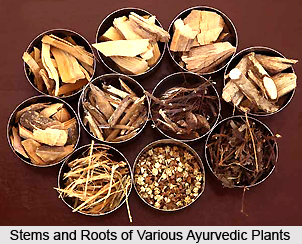 Ayurvedic concept of disease defines two terms, vikruti and prakruti. Vikruti is the abnormal or diseased condition of the body while prakruti refers to the normal physiological and mental state. The main aim of Ayurveda is to help a person remain healthy as well as to treat a person suffering from disease. According to Ashtang Ayurveda, when the bodily activities of a human being occur at an optimum level and the individual is physically, mentally and spiritually balanced, the condition is known as health. The renowned Ayurvedic sages Charaka and Vagbhata describe the conditions of health in the following manner: all the three doshas, namely vata, pitta and kapha are in equilibrium in accordance with the body type; all the seven dhatus or tissues (namely rasa, rakta, mansa, med, asthi, majja, shukra) have adequate strength and coordination; agnis or the digestive fires have a balanced concentration resulting in proper appetite, digestion and assimilation; the waste materials or malas (namely mutra, purisha and sweda), are being produced and purged in a regular manner; the sense organs or the indriyas are aptly carrying out their usual function and the mind is serene and calm. If all these conditions are maintained within the body, the individual experiences both physical and mental bliss and contentment.
Ayurvedic concept of disease defines two terms, vikruti and prakruti. Vikruti is the abnormal or diseased condition of the body while prakruti refers to the normal physiological and mental state. The main aim of Ayurveda is to help a person remain healthy as well as to treat a person suffering from disease. According to Ashtang Ayurveda, when the bodily activities of a human being occur at an optimum level and the individual is physically, mentally and spiritually balanced, the condition is known as health. The renowned Ayurvedic sages Charaka and Vagbhata describe the conditions of health in the following manner: all the three doshas, namely vata, pitta and kapha are in equilibrium in accordance with the body type; all the seven dhatus or tissues (namely rasa, rakta, mansa, med, asthi, majja, shukra) have adequate strength and coordination; agnis or the digestive fires have a balanced concentration resulting in proper appetite, digestion and assimilation; the waste materials or malas (namely mutra, purisha and sweda), are being produced and purged in a regular manner; the sense organs or the indriyas are aptly carrying out their usual function and the mind is serene and calm. If all these conditions are maintained within the body, the individual experiences both physical and mental bliss and contentment.
The Ayurvedic concept of disease defines disease as a destabilized condition of the doshas, dhatus, agnis and malas. With the attack of disease, both the internal and external harmony of the individual is disturbed. As a result, the individual experiences some kind of unpleasantness in the body, a condition termed as misery or dukhya. Ayurveda states that every living being has an innate tendency to move in the direction of healthiness and stability, a body condition characterised by the natural proportion of the doshas, dhatus, agnis and malas, the proportion which is their since birth. This natural proportion is prakriti and deviation from that is vikriti. According to Ayurveda, if one lives a natural, simple, and clean life there will always be more health than disease. When a person falls ill, ayurveda administers treatment that facilitates a gradual self-healing progression. If the body has a natural inclination towards health, then why does it fall ill? It has been said that imbalances in doshas, dhatus, agnis and malas cause disease. There are various reasons why these components become imbalanced. According to the Ayurvedic concept of disease, the different causal factors of a disease include "Asatmendriyarth Samyog", Aama, Pradnyaparadha and Parinama. "Asatmendriyarth Samyog" refers to the incorrect or excessive utilisation of the sense organs of vision, sound, smell, sense and touch. Aama is a deposition of toxins in the body as a result of indigestion. An excess of activity, diet or exercise triggers it. Pradnyaparadha refers to any wrong deeds performed by an individual as a result of any wrong decision taken by the mind. Parinama stands for any abrupt or unfavourable changes in climatic conditions that may hamper the body`s stability on prolonged exposure to it.
Summarily, it can be said that the Ayurvedic concept of disease lays stress on the bodily components. The unique feature of Ayurveda is that it assesses both the disease and the patient and treats accordingly. The Ayurvedic physician is not only concerned with the bodily components but also with the patient`s social status, the emotional dispositions, personality traits, and the general state of the patient`s physical condition and life.




















